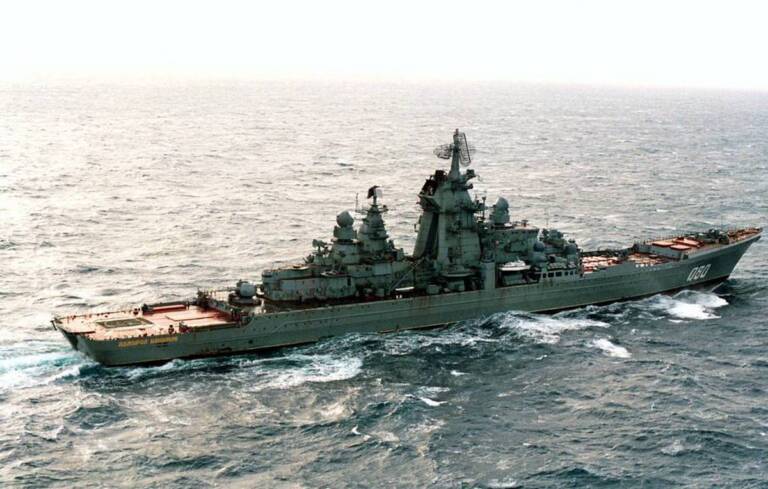The Russian fleet is not rearming, on the contrary

The Russian Navy's participation in the war against Ukraine was mostly limited to the Black Sea Fleet and the Caspian Flotilla. However, even with these limitations, Russia has lost one of its five cruisers and several other ships during the conflict (see EDM, Nov. 8, 2022). Coupled with the reconsideration of the roles and tasks of the Baltic and Northern fleets, once Finland and Sweden join the North Atlantic Treaty Organization, one might think that these developments will force Moscow to reconsider significantly exhaustive approach to its navy; instead there is still no evidence that such a reconsideration is underway. Furthermore, little evidence supports the notion that Russian shipyards actually extended working hours to boost production of warships for the Russian Navy during the war, which the Kremlin has characterized as a broader fight against West for Russia's survival (see EDM, November 28, 2022; TASS, February 26). Therefore, Moscow continues its long-term naval approach, focusing on two primary goals: (a) maintaining and developing nuclear-powered submarine forces to preserve strategic parity with the United States, and (b) developing naval forces conventional (including nuclear-powered ships), which should allow the Kremlin to project power during operations overseas to maintain Russia's role as a global player. Instead of concentrating limited resources on a predetermined number of projects, Moscow continues to spread itself too far among its numerous fleets, research and design programs and shipyards.
Russian entity United Shipbuilding Corporation ended 2022 with a net loss of tens of billion rubles ($100 million), despite reported revenues of 380 billion rubles ($5.55 billion). The company was further plagued by delays in the supply of new and repaired ships: now, six ships and submarines, instead of the originally planned 11 (Aoosk.ru, January 16; RIA Novosti, February 27). For example, the completion of the repair and modernization of the nuclear-powered cruiser Admiral Nakhimov was postponed to 2024, while it was originally planned for 2022. In fact, this process had already been delayed a couple of times. The problem is that the repair and modernization of the cruiser of the same class, Petr Velikiy, cannot be started before Admiral Nakhimov is back in operation. Meanwhile, the completion date of the repair and modernization of Russia's only aircraft carrier, the Admiral Kuznetsov, has also been postponed to 2024 (TASS, April 7, 2021)
Indeed, regarding the naval dimension, to date the only clear vision developed by the Russian military leadership is that of needing more cruise missiles on each of the new and modernized ships and diesel-electric submarines (cf. Almost all other considerations are still under discussion.For example, the future of the 677 long-term project for the development of advanced diesel-electric submarines is not yet clear, mainly due to the absence of well-developed technologies for power systems Russia (Riddle Russia, July 28, 2021). The future development of nuclear-powered missile destroyers or new aircraft carriers remains only an idea on paper. Furthermore, it has not yet been decided whether the design of the Admiral-class frigate Gorshkov (project 22356) can be further expanded or whether new, more powerful frigates should be developed instead.
Another point of discussion is whether Russia will focus on further modernization of the currently produced Borei and Yasen-class nuclear-powered submarines, or whether Moscow will invest in the production of new and as yet non-existent generations of nuclear-powered submarines after 2030. Currently, it seems that the former option is more likely, as United Shipbuilding is completing efforts to reduce the construction calendar for these classes of submarines from eight to seven years. Thus, the development of the new generations promises to stretch for decades (Interfax-AVN, August 15, 2022; RIA Novosti, February 27).
Perhaps the most important factor influencing Russian plans and discussions about its conventional vessels is related to naval engines. Since 2014, Russia has successfully reverse engineered Ukrainian-made gas turbine ship engines and developed 20-megawatt M90FR gas turbines for its M55R CODAG ship engines. Russia's production capacity is limited to two engines per year, and every Gorshkov-class frigate needs two engines to function properly (FlotProm, June 23, 2021). In addition, the same two engines are needed for the two large amphibious landing ships equipped with helicopter gunship wings (project 23900). These vessels are considered the relative counterparts of the French-built Mistral-class vessels and, as of 2020, have been
These vessels are considered the relative counterparts of the French-made Mistral-class vessels and, as of 2020, have been built in occupied Crimea by the Ak-Bars Corporation, which belongs to the main political clan of Tatarstan. Moreover, Moscow's continued interest in nuclear-powered warships testifies that serious technological and industrial problems will not allow Russia to develop and produce more powerful gas turbine naval engines in the near future (RIA Novosti, February 27).
The above all land military involvement in the Ukrainian conflict risks accentuating this cheaper reorganization of the Russian naval forces, reducing its capacity for large-scale action.

Thanks to our Telegram channel you can stay updated on the publication of new articles from Economic Scenarios.
The article The Russian fleet is not rearming, on the contrary it comes from Scenari Economici .
This is a machine translation of a post published on Scenari Economici at the URL https://scenarieconomici.it/la-flotta-russa-non-si-sta-riarmando-anzi/ on Mon, 06 Mar 2023 05:53:28 +0000.
